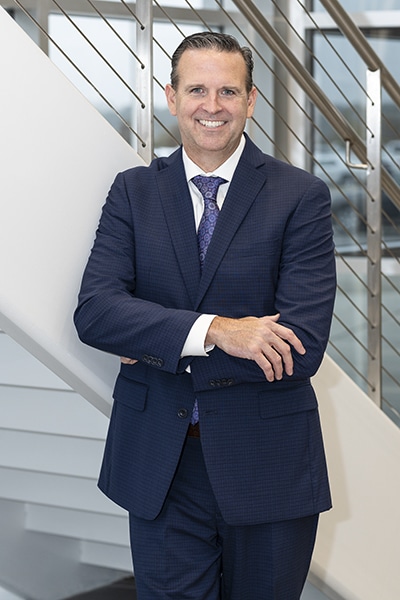|
Getting your Trinity Audio player ready... |
In deep-dive discussions on the costs and efficacy of healthcare in America—the politics, the economics of an aging population, ensuring access, and so on—there’s one topic that gets overlooked and yet is surprisingly impactful.
That topic is supply chain management. And in the case of Mayne Pharma Group Limited, a specialty pharmaceutical company focused on commercializing branded and generic drugs located in Raleigh, North Carolina, the supply chain encompasses everything from how the medications are made to how they are delivered to patients.
The company’s vice president of supply chain, Carl Turner, has no trouble connecting product inputs, software, and warehouse technologies—and the people who run these things—with human health. His mission is to identify cost-containment efficiencies wherever possible. He also has responsibilities that are, in many respects, very time-critical.
For example, Turner’s team goes to work on supporting new drugs eighteen to twenty-four months prior to those medications achieving approval from the US Food and Drug Administration (FDA). “Our supply chain team is brought in during clinical trials, which is when the procurement process begins,” he says. “That’s when we think about how our facilities or third-party manufacturers can bring these drugs to market.”
In other words, miracle drug breakthroughs are incredible and ideal, but until the logistics of manufacturing and distribution are worked out, no patient sees the benefits.
Mayne Pharma, which describes itself as a technology-driven company, develops its own drugs in addition to being a manufacturer of generic and branded pharmaceuticals. But it’s also a contract developer. Its division Metrics Contract Services is a full-service global contract development and manufacturing organization (CDMO). Metrics provides formulation development, analytical testing, and manufacturing services.
Mayne Pharma took notice of Metrics’ steady growth and acquired the company in 2012, establishing its US presence and expanding Metrics’ footprint from its small laboratory in Greenville, North Carolina to a global level. Now, Metrics serves more than one hundred pharmaceutical companies from Mayne Pharma’s recently expanded Greenville facility.
“It looks at data and analytics and removes human bias—humans have access to customer relationship knowledge that the computers do not.”
The new 126,000-square-foot facility was built for complex dosage medications, including Schedule II-V controlled substances, those containing inherently unstable compounds, and products with poor bioavailability. The site is highly regarded by its third-party customers for its potent drug capability, which is a rapidly growing area due to the growth in oncology medications. The site also meets strict regulatory and compliance requirements and is regularly audited by global regulatory agencies such as the FDA, EMA (European Medicines Agency), and PMDA (a Japanese organization similar to the FDA).
The supply chain has its own technologies that Turner’s team has been instrumental in implementing since he joined the company in 2016. One is Vanguard Predictive Planning for Pharma, which helps guide companies like Mayne Pharma to source inputs, manufacture, and distribute needed drugs based on seasonal forecasts (think colds and flu), buying patterns, and growth trends. “It looks at data and analytics and removes human bias,” Turner says. “Humans have access to customer relationship knowledge that the computers do not,” he adds, giving credit to the roughly one thousand people who work at the company.

Technology abounds in supply chain, including a type of eyeglasses worn by warehouse workers that scan and read QR codes on inventory pallets. The Google Glasses read where shipments are as the wearer looks at the codes. That information feeds into management database programs, keeping the workers’ hands free for other tasks while the product’s whereabouts are managed in real time. Known as the Warehouse Management System, it decreases shipment errors, which improves operational efficiencies and reduces the cost of waste.
Medications have expiration dates, of course, so efficiencies of distribution are critical to the company’s customers. But to those customers—which include hospital-based pharmacies, retail drug stores, specialty distributors (such as those that deliver medications to the home)—those expiration dates also place pressure on the supply network to get the quantities right. Complicating this is how orders are managed twenty-four months prior to those expiration dates, yet new medications might come onto the market in that time frame. The Vanguard software accounts for this, too.
Regulatory matters factor into Mayne Pharma’s supply chain work, including and especially the Drug Supply Chain Security Act (DSCSA), which requires a type of pharmaceutical provenance. The law began to take effect in 2014 and will continue to be phased in until 2023.
“The DSCSA enables us to know where a drug was manufactured and the lineage of its manufacturing, including if it was manufactured overseas,” says Turner. He explains that the Act—which establishes national licensure standards for wholesale distributors and third-party logistics providers—protects consumers and pharmaceutical companies alike from counterfeit, stolen, or contaminated medications and their harmful effects.
It bears noting that, largely through acquisitions, Mayne Pharma has risen from the seventy-fifth largest generic drug supplier in the US to the top thirty since 2016. This growth period coincides with advances in specialty drugs that are more complicated than simple pills, such as delayed release tablets and capsules, foams for topical application, and self-administered injectable medications. Also, home delivery of some kinds of medications (used for chronic diseases, for example) is in a growth industry.
While that final leg of the trip—how patients receive their medications—is the responsibility of the wholesalers who are Mayne Pharma’s customers, such changes at the consumer end inevitably affect the supply chain management upstream. Turner’s team manages these changes with technology and adaptive rethinking, as they have in recent years—all in the interest of quality, timing, and cost efficiency.

